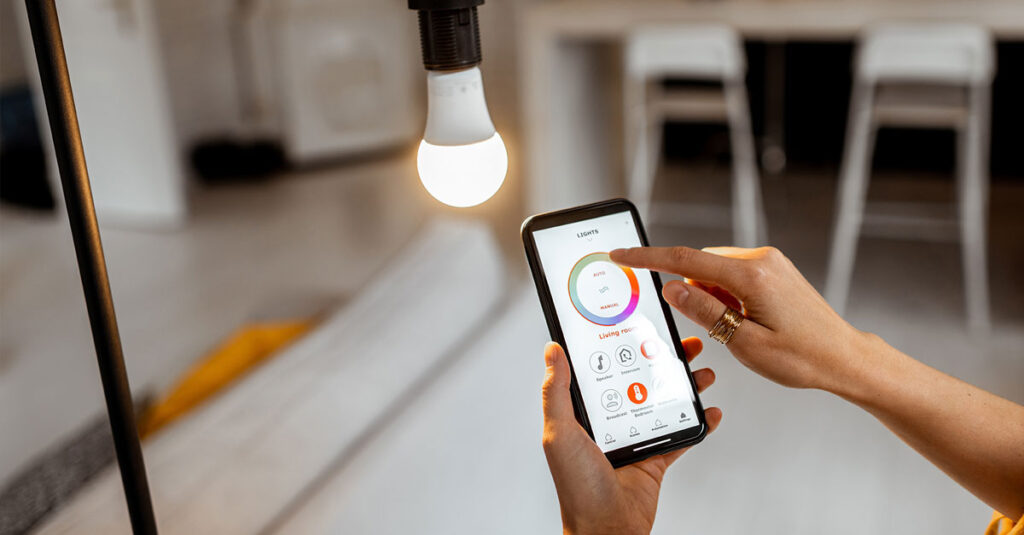
What’s New in Smart Lighting?
Smart lighting increases your home security, saves energy and adds ambiance. And given it’s one of the easiest ways to add smart technology to your home, you might have started with it. Smart home technology changes constantly, so it could be time to take a look at some easy lighting upgrades to add to your home. Let’s see what’s new.
Your first step is to make sure you have reliable Wi-Fi, powered by fast fiber internet. If you’re getting smarter, this is the time to upgrade to a fiber connection. Once you’re a Frontier Fiber customer, you can enroll in Frontier ForMe Rewards and get great discounts on lots of affordable devices.
What is smart lighting?
First, a quick review of the basics. There are three types of smart lighting:
- Smart LED (light-emitting diode) light bulbs – These are the quickest way to add smart lighting to your home. All you need to do is screw these bulbs into your existing light fixtures, whether your living room lamps or an outside sconce on your deck. You can control them remotely using a phone app or voice assistant.
- Smart wall switches – These replace your existing light switches. They automate the lights in the room.
- Smart plugs – Simply plug a lamp into a smart plug that’s plugged into a wall outlet, and that lamp becomes a smart light.
You can control all of them via your home network Wi-Fi, whether you use a smart home hub or apps you install on your phone or tablet.
What’s new with smart LED light bulbs?
Besides becoming more affordable, smart light bulbs have these improved features:
- Apps are more user-friendly and intuitive. Setting schedules and controlling groups of smart light bulbs are as simple as tapping your smartphone to manage timing, color and brightness.
- Improved technology means more reliable connectivity and fast response times when you change a setting.
- Smart bulbs have become compatible with more platforms, such as Amazon Alexa, Apple HomeKit and Google Assistant.
- Along with bright white light bulbs that go in your existing fixtures, keep an eye out for new options in floodlights, light strips, color-changing solutions and designs you can use for eye-catching décor and pre-set animations to project on your walls.
What’s new with smart lighting safety and security?
Because security is at the top of the list for smart lighting solutions, there are always upgrades. Motion-activated lights are key for automatically turning on your outdoor lights, and new technology can distinguish between movements by people, animals and swaying branches and let you select the reason for your lights to go on.
Another improvement is more seamless integration with home security systems to create a security ecosystem. If an intruder breaks into your home, your security system could automatically turn on interior lights at exactly the levels you choose.
Outside your home, the security system could turn on any exterior lights when a security camera or your doorbell camera detects someone near your doors or windows.
What’s new with smart lighting energy conservation?
The dimming controls in smart lights can lower your electric lighting bill by over 30%, according to research. Sensors in smart light bulbs are becoming better able to adjust the brightness level based on the level of light in a room. So, if there’s plenty of natural light, the smart light will dim or turn off.
The technology used in LED lighting also continues to improve. Ultra-efficient LED light bulbs are now available that can last over 50,000 hours and use 40% less energy than LED bulbs. (As a comparison, an incandescent bulb usually burns out after no more than 2,000 hours.)
The U.S. Department of Energy (DOE) reports that residential LED lights use over 75% less energy than incandescent lights. The DOE projects that by 2035, most lighting systems will use LED technology.
What’s new with smart lighting ambiance solutions?
Smart lighting can now be more finely adjusted to sync up with your internal clock that affects your physical and mental responses to light. This design trend is called circadian lighting.
For example, if you work remotely from home, smart lighting can simulate daylight to help boost your productivity. Later, as you wind down, you can program the lighting to dim and create a more relaxing environment.
You have a huge range of options to select the color “temperature,” or hue, of your smart lights. Use your colored bulbs to choose warm colors like orange or yellow to energize you early in the day. In the evening, you can switch to cool, peaceful colors like blue or green.
What’s the future of smart lighting technology?
One of the most exciting features in the works would be your ability to control your smart lights using simple hand gestures.
AI smart lighting systems on the horizon could learn your preferences at certain times of the day. For example, the brightness and color will automatically adjust to your liking when you sit down to dinner and then again when you curl up with a book before you go to sleep.
LED lights will become even more energy efficient and may use renewable energy sources like solar power.
Stay connected to home with Frontier Fiber
When you power your smart home with the best fiber internet connection, you can rest assured you have reliable access to your smart devices whenever you want to be in touch. Learn about the advantages of Frontier Fiber. Frontier Fiber is available in select areas—check here to see when it’s available at your address. Then check out Frontier’s SmartMarket for a great selection of quality smart home devices.



